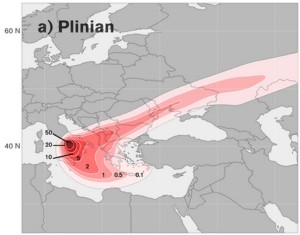 Researchers at BSC are using the MareNostrum supercomputer to study super eruptions–volcanic events with most destructive force on this planet. Only a few super volcanos exist in the world and when they erupt, they do so with a force tens of thousands of times greater than other eruptions.
Researchers at BSC are using the MareNostrum supercomputer to study super eruptions–volcanic events with most destructive force on this planet. Only a few super volcanos exist in the world and when they erupt, they do so with a force tens of thousands of times greater than other eruptions.
A new study on the Campanian Ignimbrite super-eruption, which took place some 39,000 years ago near the modern city of Naples, provides a detailed reconstruction of this natural phenomenon which slowed the advance of Modern Humans in Europe. For the first time, researchers have reconstructed the two phases of the super-eruption which deposited an amount of ash equivalent to approximately eight times the volume of Everest, between southern Italy and the Siberian plains. The study is being published today in the magazine Nature Scientific Reports.
Researchers at Barcelona Supercomputing Center (BSC) and at the Istituto Nazionale de Geofísica e Vulcanología (INGV) in Italy have reconstructed the phenomenon using hundreds of simulations carried out on the MareNostrum supercomputer. These simulations have allowed them to establish that in the first (Plinian) phase, the super-eruption generated a 44-kilometre high column and dispersed 54 km3 of fallen deposits in the surrounding areas (in what is now southern Italy). During the second (co-ignimbrite) phase, 154 km3 of finer particles were dispersed. The total deposits which accumulated over the two phases is approximately equivalent to eight times the visible part of Mount Everest, or a hundred million times the Barcelona Football Club stadium.
In total, the super-eruption of the Campanian Ignimbrite covered an area of more than three million km2, from the Mediterranean to what is now Siberia, in ash. The largest build-ups of ash were in modern Macedonia, Bulgaria and Romania, while in areas of the eastern Mediterranean layers up to 10cm thick accumulated. Ash movements and deposits, along with the methodology used to undertake this study, can be found at the BSC site.
 Another impact of the Campanian Ignimbrite eruption was that the release of ash and aerosols into the stratosphere caused a ‘volcanic winter’. Various studies have shown that this phenomenon caused global temperatures to drop by two degrees the following year, while the temperature in Western Europe dropped up by up to five degrees.
Another impact of the Campanian Ignimbrite eruption was that the release of ash and aerosols into the stratosphere caused a ‘volcanic winter’. Various studies have shown that this phenomenon caused global temperatures to drop by two degrees the following year, while the temperature in Western Europe dropped up by up to five degrees.
In addition to the effects on the natural environment, the Campanian Ignimbrite eruption has been identified as having a significant impact on the evolution of the human species in Europe, as it took place when Modern Humans had begun to advance on the continent from the Middle East, displacing the Neanderthals. The super-eruption, together with the events of the last ice age, significantly reduced the habitable area in Europe and would have contributed to slowing the transition from the Middle Paleolithic to the Upper Paleolithic, delaying the entry of Modern Humans and reducing the population which had settled in the area devastated by its ash deposits. Years later, however, this same area would become a remarkably fertile area for new settlers.
The study
The study “Reconstructing the plinian and co-ignimbrite 1 sources of large volcanic eruptions: A novel approach for the Campanian Ignimbrite”, published by Nature Scientific Reports, is available online.
Ash movements and deposits, along with the methodology used to undertake this study, can be found on the following web page: http://www.bsc.es/viz/campanian_ignimbrite/




